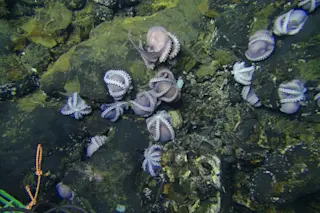Almost two miles below the surface of the Pacific Ocean, on a lonely outcrop of bare rock 100 miles from Costa Rica, researchers on a geological expedition found something odd. As their remotely controlled submersible sunk through the black waters toward the seafloor, they saw a collection of purple lumps dotting the rocky bottom.
As they got closer, they resolved themselves into something resembling a bowling ball with suckers. It was a group of female octopuses, of the genus Muusoctopus, guarding clutches of eggs they’d carefully attached to the cracks and crevices snaking across the seafloor.
It was odd, but the scientists weren’t there to admire the sea life. Led by geochemist Charles Geoffrey Wheat, the expedition was searching for warm seeps on the ocean floor, places where heat from Earth’s interior bleeds out through networks of cracks. Cooler, and less chemically rich than hydrothermal vents, the seeps are still ...














